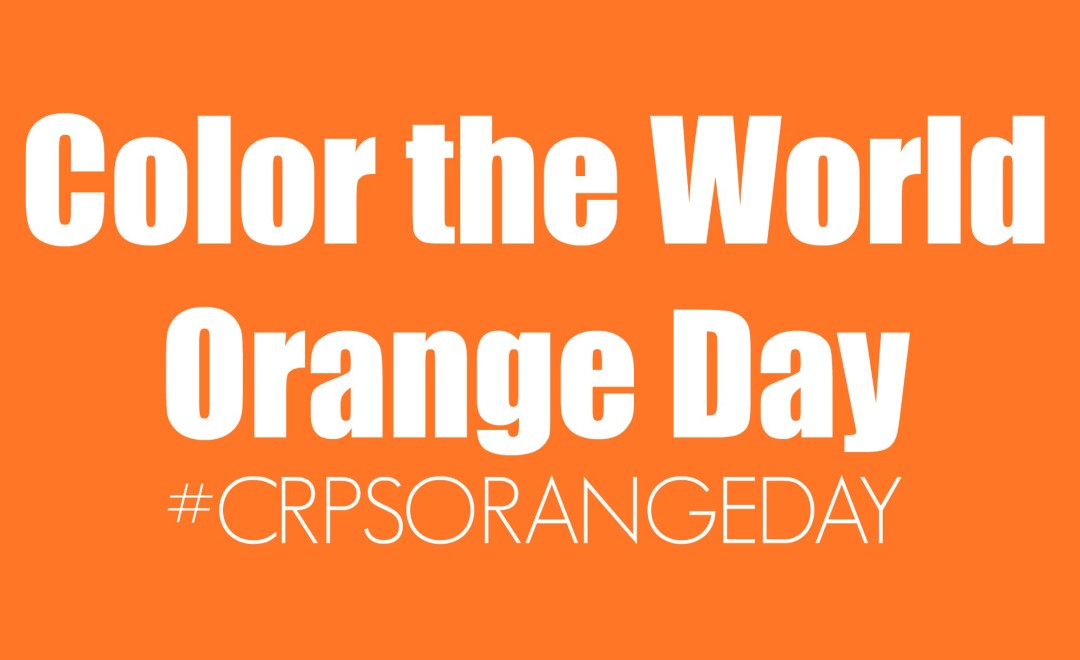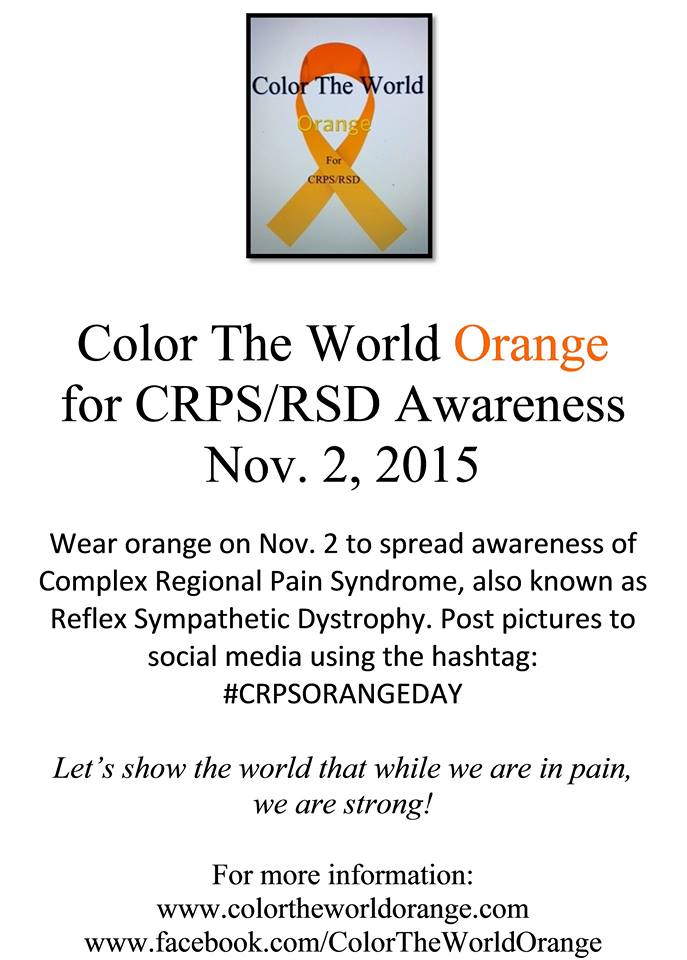Today is Color the World Orange Day – a day to spread awareness about Complex Regional Pain Syndrome. For those of you (most of you actually) who don’t know, I have lived with widespread CRPS since 2005.
What is Complex Regional Pain Syndrome?
CRPS is a chronic neurological disorder that causes intense pain in parts of the body (frequently isolated in a leg or arm) often triggered by an acute injury or trauma.
Symptoms include dull to severe pain in one particular limb but can also be spread out through the entire body. Stress, injuries, and cold temperatures can increase pain levels. While this is technically an “invisible illness,” physical changes such as swelling and discoloration can occur.
CRPS is caused by damage to or malfunction of the peripheral and central nervous systems. It is essentially a glitch in those pain signals that are sent from the brain and spinal cord to the rest of the body.
There is currently no cure – treatment includes physical/occupational therapy, biofeedback, and pain killers.
My History with CRPS
Personally, my CRPS affects my entire body but is accentuated in a few different areas. While I experience intense, dull pain throughout my entire body, I suffer from stabbing pain in my back and hands. My hands will swell and become purple when the pain is particularly intense. Cold weather and stress increase my pain levels dramatically.
Back in 2005, I had been suffering severe pain throughout my whole body after injuring my knees in a soccer tournament. I was tested for almost every disease on the planet. There seemed to be no doctor that could help me. I was reduced to a wheelchair and could not attend the second half of sixth grade. I was going to the doctor once a week to get IV infusions.
My pain restricted me from doing simple everyday tasks such as walking and bathing. I relied heavily on my parents and nanny. I couldn’t stand to be touched at all. It was a very, very dark and confusing time for me. I can honestly say I never felt more alone. Not knowing what is wrong with your body is one of the scariest feelings in the world. You feel completely and utterly helpless.
Finally, I was diagnosed with CRPS – what was then called Reflex Neurovascular Dystrophy – in the spring of 2006. At this point in time, there was little to no research on this disease – it didn’t even have a Wikipedia page.
I was given a home physical and occupational therapy treatment plan and sent on my way. Unfortunately, my pain levels were so severe, I simply lacked the motivation and ability to complete the home program effectively. At the end of summer in 2006, I was put on the wait list for Seattle Children’s Hospital’s intensive treatment program. Seattle Children’s was one of two facilities in the entire country at the time that offered this program. I was accepted into the program in the spring of 2007.
This three to eight week program consisted of intensive therapy – both mental and physical – for 6 hours a day. Since I lived close to the hospital, I was able to live at home and commute each day. I was so blessed to be able to go home every night instead of doing the in-patient program.
I ended up staying in the program for six of the most painful and difficult weeks of my life. However, they were also the most rewarding. The incredible physical and occupational therapists walked me through every step of the program. There were times where I did not want to move a single inch and channeled my anger at my body into hating my therapists. They pushed me harder than I knew possible, but what I didn’t realize at the time, was that their firmness was exactly what I needed. In six weeks, I was 80% pain-free.
CRPS & My Life Now
While I still struggle with pain on a daily basis, I am able to live a normal life. I’m attending college, have a job, volunteer, go for runs everyday, and spend time with amazing friends. Nine years ago, I would not have believed you if you told me I would be where I am today. Five years ago, I had a flare up so bad that the thought of attending college seemed like a joke.
I think my biggest struggle is not overcoming pain. My biggest struggle is living with a poorly understood, invisible illness. Physical pain seems so trivial to me now, but the emotional and mental toll is what affects me most.
There are days where I feel like I am drowning in pain – days where I can’t be touched at all, days where I can’t hold a glass of water or my phone for more than 10 seconds, days where goosebumps feel like daggers.
But there are other days where I completely forget that I’m in pain.
I have learned to embrace pain. Instead of letting it defeat me, I confront it head on. When I’m having a flare up, I always ask myself how I can use this experience to learn and grow. Coping with pain is a mental chess game – you have to be one step ahead at all times.
Living with a Chronic, Invisible Illness
The difficulty comes is when people do not understand because they cannot physically see anything wrong with me. Invisible, chronic illnesses are so often forgotten about and misunderstood. It doesn’t make sense to people why I can be totally fine one minute and in severe pain the next. It especially doesn’t make sense to people when I don’t complain about it every day.
I look normal and live a very normal life. From the outside looking in, you would never know I was living with this disease. However, just because I may not look different or act different doesn’t mean I don’t feel different. I know most people living with a chronic disease – whatever it may be – can understand this. The insensitivity of others causes more pain than anything else.
Living with a chronic, invisible illness can be incredibly isolating and lonely. I hope anybody who can relate to this post knows that they are not alone. If you ever need support or someone to listen, I am always here.
Color the World Orange Day
The first Monday of November is known as Color the World Orange Day. People all over the world are encouraged to wear orange to spread awareness about CRPS. Please consider researching the disease and learning more about how you can make a difference.
There is currently no cure, so let’s work towards finding one. While there is minimal research on this disease, raising awareness and starting a discussion about it can help encourage more to be done.
Please join me in wearing orange today to support all those affected by this disease!




